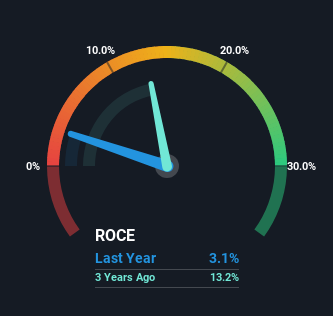- Chile
- /
- Consumer Durables
- /
- SNSE:SOCOVESA
Socovesa (SNSE:SOCOVESA) Is Reinvesting At Lower Rates Of Return
If we want to find a potential multi-bagger, often there are underlying trends that can provide clues. In a perfect world, we'd like to see a company investing more capital into its business and ideally the returns earned from that capital are also increasing. Put simply, these types of businesses are compounding machines, meaning they are continually reinvesting their earnings at ever-higher rates of return. However, after investigating Socovesa (SNSE:SOCOVESA), we don't think it's current trends fit the mold of a multi-bagger.
What Is Return On Capital Employed (ROCE)?
If you haven't worked with ROCE before, it measures the 'return' (pre-tax profit) a company generates from capital employed in its business. Analysts use this formula to calculate it for Socovesa:
Return on Capital Employed = Earnings Before Interest and Tax (EBIT) ÷ (Total Assets - Current Liabilities)
0.031 = CL$13b ÷ (CL$1.2t - CL$760b) (Based on the trailing twelve months to March 2023).
Therefore, Socovesa has an ROCE of 3.1%. Ultimately, that's a low return and it under-performs the Consumer Durables industry average of 7.9%.
Check out our latest analysis for Socovesa

Historical performance is a great place to start when researching a stock so above you can see the gauge for Socovesa's ROCE against it's prior returns. If you're interested in investigating Socovesa's past further, check out this free graph of past earnings, revenue and cash flow.
What Can We Tell From Socovesa's ROCE Trend?
When we looked at the ROCE trend at Socovesa, we didn't gain much confidence. Around five years ago the returns on capital were 17%, but since then they've fallen to 3.1%. And considering revenue has dropped while employing more capital, we'd be cautious. This could mean that the business is losing its competitive advantage or market share, because while more money is being put into ventures, it's actually producing a lower return - "less bang for their buck" per se.
Another thing to note, Socovesa has a high ratio of current liabilities to total assets of 65%. This effectively means that suppliers (or short-term creditors) are funding a large portion of the business, so just be aware that this can introduce some elements of risk. Ideally we'd like to see this reduce as that would mean fewer obligations bearing risks.
The Bottom Line
From the above analysis, we find it rather worrisome that returns on capital and sales for Socovesa have fallen, meanwhile the business is employing more capital than it was five years ago. Investors haven't taken kindly to these developments, since the stock has declined 53% from where it was five years ago. With underlying trends that aren't great in these areas, we'd consider looking elsewhere.
Socovesa does come with some risks though, we found 3 warning signs in our investment analysis, and 2 of those can't be ignored...
While Socovesa may not currently earn the highest returns, we've compiled a list of companies that currently earn more than 25% return on equity. Check out this free list here.
New: Manage All Your Stock Portfolios in One Place
We've created the ultimate portfolio companion for stock investors, and it's free.
• Connect an unlimited number of Portfolios and see your total in one currency
• Be alerted to new Warning Signs or Risks via email or mobile
• Track the Fair Value of your stocks
Have feedback on this article? Concerned about the content? Get in touch with us directly. Alternatively, email editorial-team (at) simplywallst.com.
This article by Simply Wall St is general in nature. We provide commentary based on historical data and analyst forecasts only using an unbiased methodology and our articles are not intended to be financial advice. It does not constitute a recommendation to buy or sell any stock, and does not take account of your objectives, or your financial situation. We aim to bring you long-term focused analysis driven by fundamental data. Note that our analysis may not factor in the latest price-sensitive company announcements or qualitative material. Simply Wall St has no position in any stocks mentioned.
About SNSE:SOCOVESA
Socovesa
Engages in the real estate development and construction businesses under the Almagro, Socovesa, Pilares, and Desarrollos Comerciales brands in Chile.
Fair value with mediocre balance sheet.
Similar Companies
Market Insights
Community Narratives



